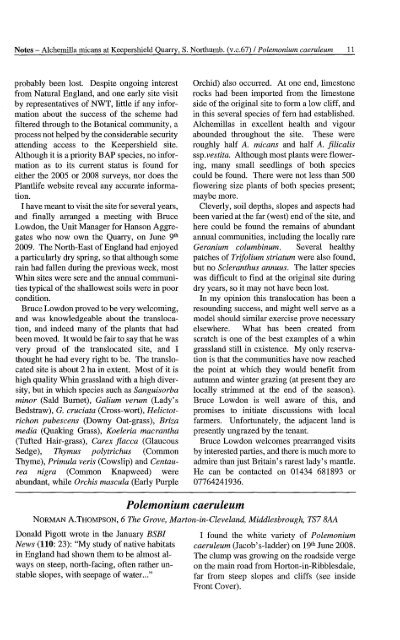BSBINews - BSBI Archive - Botanical Society of the British Isles
BSBINews - BSBI Archive - Botanical Society of the British Isles
BSBINews - BSBI Archive - Botanical Society of the British Isles
You also want an ePaper? Increase the reach of your titles
YUMPU automatically turns print PDFs into web optimized ePapers that Google loves.
Notes - Alchemilla micans at Keepershield Quarry, S. Northumb. (v.c.67) I Polemonium caeruleum 11<br />
probably been lost. Despite ongoing interest<br />
from Natural England, and one early site visit<br />
by representatives <strong>of</strong> NWT, little if any information<br />
about <strong>the</strong> success <strong>of</strong> <strong>the</strong> scheme had<br />
filtered through to <strong>the</strong> <strong>Botanical</strong> community, a<br />
process not helped by <strong>the</strong> considerable security<br />
attending access to <strong>the</strong> Keepershield site.<br />
Although it is a priority BAP species, no information<br />
as to its current status is found for<br />
ei<strong>the</strong>r <strong>the</strong> 2005 or 2008 surveys, nor does <strong>the</strong><br />
Plantlife website reveal any accurate information.<br />
I have meant to visit <strong>the</strong> site for several years,<br />
and finally arranged a meeting with Bruce<br />
Lowdon, <strong>the</strong> Unit Manager for Hanson Aggregates<br />
who now own <strong>the</strong> Quarry, on June 9 th<br />
2009. The North-East <strong>of</strong> England had enjoyed<br />
a particularly dry spring, so that although some<br />
rain had fallen during <strong>the</strong> previous week, most<br />
Whin sites were sere and <strong>the</strong> annual communities<br />
typical <strong>of</strong> <strong>the</strong> shallowest soils were in poor<br />
condition.<br />
Bruce Lowdon proved to be very welcoming,<br />
and was knowledgeable about <strong>the</strong> translocation,<br />
and indeed many <strong>of</strong> <strong>the</strong> plants that had<br />
been moved. It would be fair to say that he was<br />
very proud <strong>of</strong> <strong>the</strong> translocated site, and I<br />
thought he had every right to be. The translocated<br />
site is about 2 ha in extent. Most <strong>of</strong> it is<br />
high quality Whin grassland with a high diversity,<br />
but in which species such as Sanguisorba<br />
minor (SaId Burnet), Galium verum (Lady's<br />
Bedstraw), G. cruciata (Cross-wort), Helictotrichon<br />
pubescens (Downy Oat-grass), Briza<br />
media (Quaking Grass), Koeleria macrantha<br />
(Tufted Hair-grass), Carex flacca (Glaucous<br />
Sedge), Thymus polytrichus (Common<br />
Thyme), Primula veris (Cowslip) and Centaurea<br />
nigra (Common Knapweed) were<br />
abundant, while Orchis mascula (Early Purple<br />
Polemonium caeruleum<br />
Orchid) also occurred. At one end, limestone<br />
rocks had been imported from <strong>the</strong> limestone<br />
side <strong>of</strong> <strong>the</strong> original site to form a low cliff, and<br />
in this several species <strong>of</strong> fern had established.<br />
Alchemillas in excellent health and vigour<br />
abounded throughout <strong>the</strong> site. These were<br />
roughly half A. micans and half A. filicalis<br />
ssp.vestita. Although most plants were flowering,<br />
many small seedlings <strong>of</strong> both species<br />
could be found. There were not less than 500<br />
flowering size plants <strong>of</strong> both species present;<br />
maybe more.<br />
Cleverly, soil depths, slopes and aspects had<br />
been varied at <strong>the</strong> far (west) end <strong>of</strong> <strong>the</strong> site, and<br />
here could be found <strong>the</strong> remains <strong>of</strong> abundant<br />
annual communities, including <strong>the</strong> locally rare<br />
Geranium columbinum. Several healthy<br />
patches <strong>of</strong> Trifolium striatum were also found,<br />
but no Scleranthus annuus. The latter species<br />
was difficult to find at <strong>the</strong> original site during<br />
dry years, so it may not have been lost.<br />
In my opinion this translocation has been a<br />
resounding success, and might well serve as a<br />
model should similar exercise prove necessary<br />
elsewhere. What has been created from<br />
scratch is one <strong>of</strong> <strong>the</strong> best examples <strong>of</strong> a whin<br />
grassland still in existence. My only reservation<br />
is that <strong>the</strong> communities have now reached<br />
<strong>the</strong> point at which <strong>the</strong>y would benefit from<br />
autumn and winter grazing (at present <strong>the</strong>y are<br />
locally strimmed at <strong>the</strong> end <strong>of</strong> <strong>the</strong> season).<br />
Bruce Lowdon is well aware <strong>of</strong> this, and<br />
promises to initiate discussions with local<br />
farmers. Unfortunately, <strong>the</strong> adjacent land is<br />
presently ungrazed by <strong>the</strong> tenant.<br />
Bruce Lowdon welcomes prearranged visits<br />
by interested parties, and <strong>the</strong>re is much more to<br />
admire than just Britain's rarest lady's mantle.<br />
He can be contacted on 01434 681893 or<br />
07764241936.<br />
NORMAN A.THOMPSON, 6 The Grove, Marton-in-Cleveland, Middlesbrough, TS78AA<br />
Donald Pigott wrote in <strong>the</strong> January <strong>BSBI</strong><br />
News (110: 23): "My study <strong>of</strong> native habitats<br />
in England had shown <strong>the</strong>m to be almost always<br />
on steep, north-facing, <strong>of</strong>ten ra<strong>the</strong>r unstable<br />
slopes, with seepage <strong>of</strong> water ... "<br />
I found <strong>the</strong> white variety <strong>of</strong> Polemonium<br />
caeruleum (Jacob's-ladder) on 19 th June 2008.<br />
The clump was growing on <strong>the</strong> roadside verge<br />
on <strong>the</strong> main road from Horton-in-Ribblesdale,<br />
far from steep slopes and cliffs (see inside<br />
Front Cover).

















